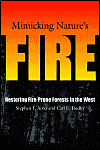book
Mimicking Nature's Fire: Restoring Fire-Prone Forests in the West
by Stephen F. Arno '65 and Carl E. Fiedler :: Island Press :: Reviewed by Dale Goble

The book is divided into three parts. The first sets the stage. The authors discuss the historical fire regimes that shaped the forests that were present when Euro-Americans arrived in the West. They then turn to the ecological, political, and economic barriers to restoration forestry before concluding with an overview of its objectives, techniques, and economics.
The second and largest section examines a series of restoration projects, contrasting forest types, fire regimes, and management goals. These chapters analyze not only the ecological considerations but also the political issues that often are even more important in shaping the forests. Restoration forestry often requires a mix of thinning and fire, depending on forest type and the social and ecological context of the stand.
The book concludes with a short, clear statement of what is needed. Arno and Fiedler argue for active management of the forests, noting that unintended consequences of doing nothing—yielding to the temptation to "let nature take its course"—is a recipe for disasters such as the stand-replacing fires that have become a recurrent feature of Western summers.
The writing is clear and accessible to non-specialists. The text is enhanced with well-chosen photographs, line drawings, and helpful graphs. Although written for a general audience, the book includes nearly 20 pages of references that an interested reader can use to examine the issues in more detail.
— Dale Goble, Margaret Wilson Schimke Distinguished Professor of Law, University of Idaho